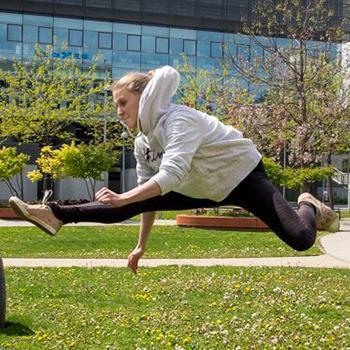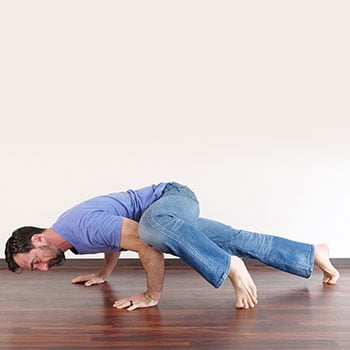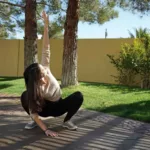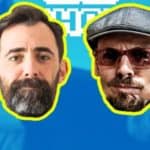It’s difficult to exaggerate the importance of hip flexibility and strength for every athletic activity.
 The hips provide most of the incredible power and force that our lower body can generate for running and jumping, and deficiencies in strength and flexibility in this area of the body can mean the difference between a winning performance or a painful end to the game.
The hips provide most of the incredible power and force that our lower body can generate for running and jumping, and deficiencies in strength and flexibility in this area of the body can mean the difference between a winning performance or a painful end to the game.
Beyond athletic activities, though, issues with your hips can negatively impact your daily life.
Possible issues include pain, decreased mobility for activities such as stooping and squatting, and even difficulty with simple daily encounters such as jumping over a puddle in the street.
Just as in my previous articles on knee health and shoulder pain, I’d like to share some essential points about the hips that can help you understand a bit more about what’s happening in this area and how it can impact your training and life.
🆓 Assess and Address Your Chronic Stiffness and Pain with our Body Maintenance Guide
- Based on physical therapy and pain science
- Head-to-toe diagnostics for the most common movement restrictions
- Specific interventions and preventative exercises
Contents: How the Hip Works / Most Common Hip Issues / Hip Flexibility Video / Hip Strength Video / Hip Exploration Video / Download our Body Maintenance Guide
Let’s Take a Look at Hip Structure

This is just one part of the complex hip joint.
When my patients and clients describe some of their hip issues to me, they can point to a pretty wide area that seems to be anywhere from right below their low back to the middle of their legs.
And actually, because of all the various muscles and structures in the region, that’s very reasonable.
Though the hip joint itself refers to the femoral head (the “ball” on the top of your leg) connecting to the acetabulum (the “socket”) of the pelvis, it really is a much bigger area than you might think, especially when we account for the large amount of myofascial structures surrounding the joint.
Just to give you a picture of what’s shaking in your hip, here’s a list of the relevant muscles:
- Hip Flexors (rectus femoris, pectineus, psoas, iliacus, tensor fascia lata)
- Hip Extensors (gluteus maximus, semitendinosus, semimembranosus, biceps femoris)
- Hip Rotators and Abductors (quadratus femoris, obturator internus, gemilli, gluteus medius, gluteus minimus, piriformis, sartorius)
- Hip Adductors (adductor longus, adductor brevis, adductor magnus, obturator externus, gracilis)
All of these muscles support and allow the hip to move and generate force in a variety of angles and positions.
Weakness and decreased flexibility in any of these muscles can compromise performance and possibly generate pain through inappropriate stress and strain from normal daily and recreational activities.
The 3 Most Common Hip Complaints
There are lots of things that could happen in the hips, as this is a fairly complex area of the body, but the two most common issues are:
1. Muscle Strains
The primary pain complaints regarding the hip are muscle strains (in the hamstrings, hip adductors, flexors) due to unfamiliar exertion or overuse, with the root cause of poor movement patterns as a result of deficient strength, flexibility, and/or coordination.
2. Hip Tightness
The primary non-painful complaints about the hips are in regards to hip tightness. Perhaps it’s because of all the sitting we do, in our cars, at our desks at work, and on the couch plopped in front of the TV, but we lose a lot of the natural hip flexibility we had as children.
Unless your day job has you squatting and twisting on a regular basis, it’d do us well to take our hips through a much greater range of motion than is needed for our daily tasks alone. (You can use our popular hip mobility routine to address this!)
3. Weak Hips
Decreased strength is a concern as well, since the big (and small) muscles surrounding the hip need more stimulation than is gained from everyday walking. The prevalence of hamstring and groin strains in “weekend warriors” is a testament to how poorly conditioned we are for more athletic activities when we spend 6 days out of 7 sitting on our butts.
It would be oversimplifying to the point of error to generally identify particular hip muscles as either weak or tight. Just as most everybody thinks they have tight hamstrings, whereas in all likelihood they instead have weak hamstrings and weak glutes.
Tightness doesn’t necessarily go along with strength, nor flexibility with weakness. It is entirely possible, and likely more probable, to be both tight and weak simultaneously, especially at the hips.
How to Build Flexible and Strong Hips
So, you know by now that, to build the healthiest hips possible, they need to be both strong and flexible–one or the other won’t cut it.
In the following videos, I’ll show you some exercise variations to improve these attributes. These exercises will help you address the various weaknesses and inflexibilities that tend to build up over years of misuse and poor movement patterns.
Hip Flexibility Training Video
I’ve shown a variety of hip stretches and flexibility exercises in previous articles, and there’s literally no end to flexibility material on YouTube and other sites online.
So, in this latest video, I wanted to share some twists on old standbys to demonstrate how to approach flexibility training in a less regimented and more exploratory manner.
In general I suggest moving in and out of a stretch a few times before holding the position for 30 seconds or longer. This serves as both a warmup and as a natural priming for the muscles to accept a stretch without the natural reflex resistance.
Don’t worry about sets and reps and hold times; instead, re-frame stretching as experimenting with different angles and positions.
From time to time we get comments from people that they “can’t even get into the starting position” of some of the stretches we show. Well really, the starting position is wherever you can start it. The idea is not to mimic the exercises exactly but to begin wherever you can, and go from there.
Hip Strength Training Video
The standard big strength moves such as squats and lunges are important pieces for building great hip and leg strength, but be wary of training the same patterns over and over again. It’s nothing to do with “muscle confusion” or any nonsense like that; rather, it’s that we tend to form fixed movement patterns with consistent repetition of any skill.
In this video I’ll show you a few new ways to change up classic leg strength exercises. Give these a test run and let it inspire you to create some variations of your own.
Again, don’t worry too much about sets or reps. Just see this as an opportunity to practice.
Change Things Up for Consistent Results
Strong and flexible hips are key for nearly every athletic endeavor, as well as many aspects of normal, daily life. Since they are key players in both generating force and attenuating strain, the hips are protective for the low back and the knees.
Too often we find ourselves performing the same movements every day. Absorbed in the routine of work and home life, we lose sight of our hips’ incredible potential strength and mobility. Spend even just ten to fifteen minutes a day on fundamental and creative hip exercises and you’ll notice a dramatic increase in your ability to move your whole body strongly and gracefully.
In this video, I’ll show you some examples of moving your hips in new and unique ways.
Athletic ability is measured by quick movement change, creative actions, and the right use of your strength at the right time.
Just as you should strive to be consistent in your exercise plan, you should also be vigilant in continually assessing your strengths and weaknesses. With these various findings and applying your observations into your regimen, you can persist in productive training throughout your life.
Poor movement involves a combination of strength, flexibility, and motor control/coordination so it behooves us to work on a diverse range of movement and exercise, both to keep us motivated and optimally functioning.
Explore What Your Hips Can Do
It’s great to have a foundation of a regimented exercise routine and plan, which along with consistent, hard effort, brings the best increases in performance and ability. This is especially true for beginners and people returning to their training after a long period off.
But at some point you’ll be hitting diminished returns based upon the time spent doing the same repetitive actions day after day. When you start to feel stale, or your energy levels drop, remember the fun you had as a child just playing around, and seeing what new things you could do with your body.
Take your time and give yourself room to explore all the various actions and positions your hips can handle. This is the true key to improving all aspects of your hips range of motion and power.
And if, like many people, you find that tight hips accompany other aches and pains in your body, our GMB Mobility program will help you tackle the areas that are holding you back, so that you can move freely in every area of your life.
Build Flexibility That Actually Helps You Move
GMB Mobility is a guided program that improves your total body mobility. You’ll resolve restrictions so you can finally move and perform your best.






